FENTANYL CITRATE injection, solution
Fentanyl Citrate by
Drug Labeling and Warnings
Fentanyl Citrate by is a Prescription medication manufactured, distributed, or labeled by Hospira, Inc.. Drug facts, warnings, and ingredients follow.
Drug Details [pdf]
-
HIGHLIGHTS OF PRESCRIBING INFORMATION
These highlights do not include all the information needed to use FENTANYL CITRATE INJECTION safely and effectively. See full prescribing information for FENTANYL CITRATE INJECTION.
FENTANYL CITRATE Injection, for Intravenous or Intramuscular use, CII
Initial U.S. Approval: 1968WARNING: ADDICTION, ABUSE, AND MISUSE; LIFE-THREATENING RESPIRATORY DEPRESSION; CYTOCHROME P450 3A4 INTERACTION; and RISKS FROM CONCOMITANT USE WITH BENZODIAZEPINES OR OTHER CNS DEPRESSANTS
See full prescribing information for complete boxed warning.
- Fentanyl Citrate Injection exposes users to risks of addiction, abuse, and misuse, which can lead to overdose and death. Assess patient's risk before prescribing and monitor regularly for these behaviors and conditions. (5.1)
- Serious, life-threatening, or fatal respiratory depression may occur. Monitor closely, especially upon initiation or following a dose increase. (5.2)
- Concomitant use with CYP3A4 inhibitors (or discontinuation of CYP3A4 inducers) can result in a fatal overdose of fentanyl. (5.3, 7, 12.3).
- Concomitant use of opioids with benzodiazepines or other central nervous system (CNS) depressants, including alcohol, may result in profound sedation, respiratory depression, coma, and death. Reserve concomitant prescribing for use in patients for whom alternative treatment options are inadequate; limit dosages and durations to the minimum required; and follow patients for signs and symptoms of respiratory depression and sedation. (5.4, 7)
RECENT MAJOR CHANGES
Warnings and Precautions (5.2) 10/2019 INDICATIONS AND USAGE
Fentanyl Citrate Injection is an opioid agonist indicated for: (1)
- analgesic action of short duration during the anesthetic periods, premedication, induction and maintenance, and in the immediate postoperative period (recovery room) as the need arises.
- use as an opioid analgesic supplement in general or regional anesthesia.
- administration with a neuroleptic as an anesthetic premedication, for the induction of anesthesia and as an adjunct in the maintenance of general and regional anesthesia.
- use as an anesthetic agent with oxygen in selected high risk patients, such as those undergoing open heart surgery or certain complicated neurological or orthopedic procedures.
DOSAGE AND ADMINISTRATION
- Fentanyl Citrate Injection should be administered only by persons specifically trained in the use of intravenous anesthetics and management of the respiratory effects of potent opioids.
- Ensure that an opioid antagonist, resuscitative and intubation equipment, and oxygen are readily available. (2.1)
- Individualize dosing based on the factors such as age, body weight, physical status, underlying pathological condition, use of other drugs, type of anesthesia to be used, and the surgical procedure involved. (2.1)
- Initiate treatment in adults with 50 to 100 mcg (0.05 to 0.1 mg) (1 to 2 mL). (2.2)
- Initiate treatment in children 2 to 12 years of age with a reduced dose as low as 2 to 3 mcg/kg. (2.2)
DOSAGE FORMS AND STRENGTHS
CONTRAINDICATIONS
- Hypersensitivity to fentanyl. (4)
WARNINGS AND PRECAUTIONS
- Risks of Skeletal Muscle Rigidity and Skeletal Muscle Movement: Manage with neuromuscular blocking agent. See full prescribing information for more detail on managing these risks. (5.5)
- Severe Cardiovascular Depression: Monitor during dosage initiation and titration. (5.6)
- Serotonin Syndrome: Potentially life-threatening condition could result from concomitant serotonergic drug administration. Discontinue Fentanyl Citrate Injection if serotonin syndrome is suspected. (5.7)
- Adrenal Insufficiency: If diagnosed, treat with physiologic replacement of corticosteroids, and wean patient off of the opioid. (5.8)
- Risks of Use in Patients with Increased Intracranial Pressure, Brain Tumors, Head Injury, or Impaired Consciousness: Monitor for sedation and respiratory depression. (5.9)
ADVERSE REACTIONS
Most common serious adverse reactions were respiratory depression, apnea, rigidity, and bradycardia. (6)
To report SUSPECTED ADVERSE REACTIONS, contact Hospira, Inc. at 1-800-441-4100, or FDA at 1-800-FDA-1088 or www.fda.gov/medwatch.
DRUG INTERACTIONS
- Concomitant Use of CNS Depressants: May decrease pulmonary arterial pressure and may cause hypotension. See FPI for management instructions. For post-operative pain, start with the lowest effective dosage and monitor for potentiation of CNS depressant effects. (5.4, 7)
- Mixed Agonist/Antagonist and Partial Agonist Opioid Analgesics: Avoid use with Fentanyl Citrate Injection because they may reduce analgesic effect of Fentanyl Citrate Injection or precipitate withdrawal symptoms. (7)
USE IN SPECIFIC POPULATIONS
See 17 for PATIENT COUNSELING INFORMATION.
Revised: 10/2019
-
Table of Contents
FULL PRESCRIBING INFORMATION: CONTENTS*
WARNING: ADDICTION, ABUSE, AND MISUSE; LIFE-THREATENING RESPIRATORY DEPRESSION; CYTOCHROME P450 3A4 INTERACTION; and RISKS FROM CONCOMITANT USE WITH BENZODIAZEPINES OR OTHER CNS DEPRESSANTS
1 INDICATIONS AND USAGE
2 DOSAGE AND ADMINISTRATION
2.1 Important Dosage and Administration Instructions
2.2 Dosage
3 DOSAGE FORMS AND STRENGTHS
4 CONTRAINDICATIONS
5 WARNINGS AND PRECAUTIONS
5.1 Addiction, Abuse, and Misuse
5.2 Life-Threatening Respiratory Depression
5.3 Risks of Concomitant Use or Discontinuation of Cytochrome P450 3A4 Inhibitors and Inducers
5.4 Risks from Concomitant Use with Benzodiazepines or Other Central Nervous System Depressants
5.5 Risks of Muscle Rigidity and Skeletal Muscle Movement
5.6 Severe Cardiovascular Depression
5.7 Serotonin Syndrome with Concomitant Use of Serotonergic Drugs
5.8 Adrenal Insufficiency
5.9 Risks of Use in Patients with Increased Intracranial Pressure, Brain Tumors, or Head Injury
5.10 Risks of Use in Patients with Gastrointestinal Conditions
5.11 Increased Risk of Seizures in Patients with Seizure Disorders
5.12 Risks of Driving and Operating Machinery
5.13 Risks due to Interaction with Neuroleptic Agents
6 ADVERSE REACTIONS
7 DRUG INTERACTIONS
8 USE IN SPECIFIC POPULATIONS
8.1 Pregnancy
8.2 Lactation
8.3 Females and Males of Reproductive Potential
8.4 Pediatric Use
8.5 Geriatric Use
8.6 Hepatic Impairment
8.7 Renal Impairment
9 DRUG ABUSE AND DEPENDENCE
9.1 Controlled Substance
9.2 Abuse
9.3 Dependence
10 OVERDOSAGE
11 DESCRIPTION
12 CLINICAL PHARMACOLOGY
12.1 Mechanism of Action
12.2 Pharmacodynamics
12.3 Pharmacokinetics
13 NONCLINICAL TOXICOLOGY
13.1 Carcinogenesis, Mutagenesis, Impairment of Fertility
16 HOW SUPPLIED/STORAGE AND HANDLING
17 PATIENT COUNSELING INFORMATION
- * Sections or subsections omitted from the full prescribing information are not listed.
-
BOXED WARNING
(What is this?)
WARNING: ADDICTION, ABUSE, AND MISUSE; LIFE-THREATENING RESPIRATORY DEPRESSION; CYTOCHROME P450 3A4 INTERACTION; and RISKS FROM CONCOMITANT USE WITH BENZODIAZEPINES OR OTHER CNS DEPRESSANTS
Addiction, Abuse, and Misuse
Fentanyl Citrate Injection exposes patients and other users to the risks of opioid addiction, abuse, and misuse, which can lead to overdose and death. Assess each patient's risk prior to prescribing Fentanyl Citrate Injection, and monitor all patients regularly for the development of these behaviors and conditions [see Warnings and Precautions (5.1)].
Life-Threatening Respiratory Depression
Serious, life-threatening, or fatal respiratory depression may occur with use of Fentanyl Citrate Injection. Monitor for respiratory depression, especially during initiation of Fentanyl Citrate Injection or following a dose increase [see Warnings and Precautions (5.2)].
Cytochrome P450 3A4 Interaction
The concomitant use of Fentanyl Citrate Injection with all cytochrome P450 3A4 inhibitors may result in an increase in fentanyl plasma concentrations, which could increase or prolong adverse reactions and may cause potentially fatal respiratory depression. In addition, discontinuation of a concomitantly used cytochrome P450 3A4 inducer may result in an increase in fentanyl plasma concentration. Monitor patients receiving Fentanyl Citrate Injection and any CYP3A4 inhibitor or inducer [see Warnings and Precautions (5.3), Drug Interactions (7), Clinical Pharmacology (12.3)].
Risks From Concomitant Use With Benzodiazepines Or Other CNS Depressants
Concomitant use of opioids with benzodiazepines or other central nervous system (CNS) depressants, including alcohol, may result in profound sedation, respiratory depression, coma, and death [see Warnings and Precautions (5.4), Drug Interactions (7)].
- Reserve concomitant prescribing of Fentanyl Citrate Injection and benzodiazepines or other CNS depressants for use in patients for whom alternative treatment options are inadequate.
- Limit dosages and durations to the minimum required.
- Follow patients for signs and symptoms of respiratory depression and sedation.
-
1 INDICATIONS AND USAGE
Fentanyl Citrate Injection is indicated for:
- analgesic action of short duration during the anesthetic periods, premedication, induction and maintenance, and in the immediate postoperative period (recovery room) as the need arises.
- use as an opioid analgesic supplement in general or regional anesthesia.
- administration with a neuroleptic as an anesthetic premedication, for the induction of anesthesia and as an adjunct in the maintenance of general and regional anesthesia.
- use as an anesthetic agent with oxygen in selected high risk patients, such as those undergoing open heart surgery or certain complicated neurological or orthopedic procedures.
-
2 DOSAGE AND ADMINISTRATION
2.1 Important Dosage and Administration Instructions
Fentanyl Citrate Injection should be administered only by persons specifically trained in the use of intravenous anesthetics and management of the respiratory effects of potent opioids.
- Ensure that an opioid antagonist, resuscitative and intubation equipment, and oxygen are readily available.
- Individualize dosage based on factors such as age, body weight, physical status, underlying pathological condition, use of other drugs, type of anesthesia to be used, and the surgical procedure involved.
- Monitor vital signs routinely.
As with other potent opioids, the respiratory depressant effect of fentanyl may persist longer than the measured analgesic effect. The total dose of all opioid agonists administered should be considered by the practitioner before ordering opioid analgesics during recovery from anesthesia.
If Fentanyl Citrate Injection is administered with a CNS depressant, become familiar with the properties of each drug, particularly each product's duration of action. In addition, when such a combination is used, fluids and other countermeasures to manage hypotension should be available [see Warnings and Precautions (5.4)].
Inspect parenteral drug products visually for particulate matter and discoloration prior to administration, whenever solution and container permit.
2.2 Dosage
50 mcg = 0.05 mg = 1 mL
Premedication in Adults
50 to 100 mcg (0.05 to 0.1 mg) (1 to 2 mL) may be administered intramuscularly 30 to 60 minutes prior to surgery.
Adjunct to General Anesthesia
See Dosage Range Charts below.
Table 1: Dosage Range Chart TOTAL DOSAGE (expressed as fentanyl base) Low Dose – Moderate Dose – High Dose – 2 mcg/kg
(0.002 mg/kg)
(0.04 mL/kg).
For use in minor, but painful, surgical procedures. May also provide some pain relief in the immediate postoperative period.2–20 mcg/kg
(0.002–0.02 mg/kg)
(0.04–0.4 mL/kg).
For use in major surgical procedures, in addition to adequate analgesia, may abolish some of the stress response. Expect respiratory depression requiring artificial ventilation during anesthesia and careful observation of ventilation postoperatively is essential.20–50 mcg/kg
(0.02–0.05 mg/kg)
(0.4–1 mL/kg).
For open heart surgery and certain more complicated neurosurgical and orthopedic procedures where surgery is more prolonged, and the stress response to surgery would be detrimental to the wellbeing of the patient. In conjunction with nitrous oxide/oxygen has been shown to attenuate the stress response as defined by increased levels of circulating growth hormone, catecholamine, ADH and prolactin. Expect the need for postoperative ventilation and observation are essential due to extended postoperative respiratory depression.MAINTENANCE DOSE (expressed as fentanyl base) Low Dose – Moderate Dose – High Dose – 2 mcg/kg
(0.002 mg/kg)
(0.04 mL/kg).
Additional dosages are infrequently needed in these minor procedures.2–20 mcg/kg
(0.002–0.02 mg/kg)
(0.04–0.4 mL/kg).
25 to 100 mcg (0.025 to 0.1 mg) (0.5 to 2 mL)
Administer intravenously or intramuscularly as needed when movement and/or changes in vital signs indicate surgical stress or lightening of analgesia.20–50 mcg/kg
(0.02–0.05 mg/kg)
(0.4–1 mL/kg).
Maintenance dosage [ranging from 25 mcg (0.025 mg) (0.5 mL) to one half the initial loading dose] as needed based on vital signs changes indicative of stress and lightening of analgesia. Individualize dosage especially if the anticipated remaining operative time is short.Adjunct to Regional Anesthesia
50 to 100 mcg (0.05 to 0.1 mg) (1 to 2 mL) may be administered intramuscularly or slowly intravenously, over one to two minutes, when additional analgesia is required.
Postoperatively (recovery room)
50 to 100 mcg (0.05 to 0.1 mg) (1 to 2 mL) may be administered intramuscularly for the control of pain, tachypnea and emergence delirium. The dose may be repeated in one to two hours as needed.
For Induction and Maintenance in Children 2 to 12 Years of Age
A reduced dose as low as 2 to 3 mcg/kg is recommended.
As a General Anesthetic
As a technique to attenuate the responses to surgical stress without the use of additional anesthetic agents, doses of 50 to 100 mcg/kg (0.05 to 0.1 mg/kg) (1 to 2 mL/kg) may be administered with oxygen and a muscle relaxant. In certain cases, doses up to 150 mcg/kg (0.15 mg/kg) (3 mL/kg) may be necessary to produce this anesthetic effect. It has been used for open heart surgery and certain other major surgical procedures in patients for whom protection of the myocardium from excess oxygen demand is particularly indicated, and for certain complicated neurological and orthopedic procedures.
- 3 DOSAGE FORMS AND STRENGTHS
-
4 CONTRAINDICATIONS
Fentanyl Citrate Injection is contraindicated in patients with:
- Hypersensitivity to fentanyl (e.g., anaphylaxis) [see Adverse Reactions (6)].
-
5 WARNINGS AND PRECAUTIONS
5.1 Addiction, Abuse, and Misuse
Fentanyl Citrate Injection contains fentanyl, a Schedule CII controlled substance. As an opioid, Fentanyl Citrate Injection exposes users to the risks of addiction, abuse, and misuse [see Drug Abuse and Dependence (9)].
Opioids are sought by drug abusers and people with addiction disorders and are subject to criminal diversion. Consider these risks when handling Fentanyl Citrate Injection. Strategies to reduce these risks include proper product storage and control practices for a C-II drug. Contact local state professional licensing board or state controlled substances authority for information on how to prevent and detect abuse or diversion of this product.
5.2 Life-Threatening Respiratory Depression
Serious, life-threatening, or fatal respiratory depression has been reported with the use of opioids, even when used as recommended. Respiratory depression, if not immediately recognized and treated, may lead to respiratory arrest and death. Adequate facilities should be available for postoperative monitoring and ventilation of patients administered anesthetic doses of Fentanyl Citrate Injection. It is essential that these facilities be fully equipped to handle all degrees of respiratory depression. Management of respiratory depression may include close observation, supportive measures, and use of opioid antagonists, depending on the patient's clinical status [see Overdosage (10)]. Carbon dioxide (CO2) retention from opioid-induced respiratory depression can exacerbate the sedating effects of opioids.
To reduce the risk of respiratory depression, proper dosing and titration of Fentanyl Citrate Injection are essential [see Dosage and Administration (2)]. As with other potent opioids, the respiratory depressant effect of fentanyl may persist longer that the measured analgesic effect. The total dose of all opioid agonists administered should be considered by the practitioner before ordering opioid analgesics during recovery from anesthesia.
Certain forms of conduction anesthesia, such as spinal anesthesia and some peridural anesthetics, can alter respiration by blocking intercostal nerves. Through other mechanisms [see Clinical Pharmacology (12.2)] Fentanyl Citrate Injection can also alter respiration. Therefore, when Fentanyl Citrate Injection is used to supplement these forms of anesthesia, the anesthetist should be familiar with the physiological alterations involved, and be prepared to manage them in the patients selected for these forms of anesthesia.
Patients with significant chronic obstructive pulmonary disease or cor pulmonale, and those with a substantially decreased respiratory reserve, hypoxia, hypercapnia, or pre-existing respiratory depression are at increased risk of decreased respiratory drive including apnea, even at recommended dosages of Fentanyl Citrate Injection. Elderly, cachectic, or debilitated patients may have altered pharmacokinetics or altered clearance compared to younger, healthier patients resulting in greater risk for respiratory depression.
Monitor such patients closely including vital signs, particularly when initiating and titrating Fentanyl Citrate Injection and when Fentanyl Citrate Injection is given concomitantly with other drugs that depress respiration. To reduce the risk of respiratory depression, proper dosing and titration of Fentanyl Citrate Injection are essential [see Dosage and Administration (2)].
Opioids can cause sleep-related breathing disorders including central sleep apnea (CSA) and sleep-related hypoxemia. Opioid use increases the risk of CSA in a dose-dependent fashion. In patients who present with CSA, consider decreasing the opioid dosage using best practices for opioid taper [see Dosage and Administration (2.1)].
5.3 Risks of Concomitant Use or Discontinuation of Cytochrome P450 3A4 Inhibitors and Inducers
Concomitant use of Fentanyl Citrate Injection with a CYP3A4 inhibitor, such as macrolide antibiotics (e.g., erythromycin), azole-antifungal agents (e.g., ketoconazole), and protease inhibitors (e.g., ritonavir), may increase plasma concentrations of fentanyl and prolong opioid adverse reactions, which may exacerbate respiratory depression [see Warnings and Precautions (5.2)], particularly when an inhibitor is added after a stable dose of Fentanyl Citrate Injection is achieved. Similarly, discontinuation of a CYP3A4 inducer, such as rifampin, carbamazepine, and phenytoin, in Fentanyl Citrate Injection-treated patients may increase fentanyl plasma concentrations and prolong opioid adverse reactions. When using Fentanyl Citrate Injection with CYP3A4 inhibitors or discontinuing CYP3A4 inducers in Fentanyl Citrate Injection-treated patients, monitor patients closely at frequent intervals and consider dosage reduction of Fentanyl Citrate Injection [see Dosage and Administration (2.1), Drug Interactions (7)].
Concomitant use of Fentanyl Citrate Injection with CYP3A4 inducers, or discontinuation of a CYP3A4 inhibitor, could result in lower than expected fentanyl plasma concentrations and decrease efficacy. When using Fentanyl Citrate Injection with CYP3A4 inducers or discontinuation of a CYP3A4 inhibitor, monitor patients closely at frequent intervals and consider increasing the fentanyl dosage. [see Dosage and Administration (2.1), Drug Interactions (7)].
5.4 Risks from Concomitant Use with Benzodiazepines or Other Central Nervous System Depressants
When benzodiazepines or other CNS depressants are used with Fentanyl Citrate Injection, pulmonary arterial pressure may be decreased. This fact should be considered by those who conduct diagnostic and surgical procedures where interpretation of pulmonary arterial pressure measurements might determine final management of the patient. When high dose or anesthetic dosages of Fentanyl Citrate Injection are employed, even relatively small dosages of diazepam may cause cardiovascular depression.
When Fentanyl Citrate Injection is used with CNS depressants, hypotension can occur. If it occurs, consider the possibility of hypovolemia and manage with appropriate parenteral fluid therapy. When operative conditions permit, consider repositioning the patient to improve venous return to the heart. Exercise care in moving and repositioning of patients because of the possibility of orthostatic hypotension. If volume expansion with fluids plus other countermeasures do not correct hypotension, consider administration of pressor agents other than epinephrine. Epinephrine may paradoxically decrease blood pressure in patients treated with a neuroleptic that blocks alpha adrenergic activity.
Profound sedation, respiratory depression, coma, and death may result from the concomitant use of Fentanyl Citrate Injection with benzodiazepines or other CNS depressants (e.g., non-benzodiazepine sedatives/hypnotics, anxiolytics, tranquilizers, muscle relaxants, general anesthetics, antipsychotics, other opioids, alcohol).
If the decision is made to manage postoperative pain with Fentanyl Citrate Injection concomitantly with a benzodiazepine or other CNS depressant, start dosing with the lowest effective dosage and titrate based on clinical response. Follow patients closely for signs and symptoms of respiratory depression, sedation, and hypotension. Fluids or other measures to counter hypotension should be available. [see Drug Interactions (7)].
5.5 Risks of Muscle Rigidity and Skeletal Muscle Movement
Fentanyl Citrate Injection may cause muscle rigidity, particularly involving the muscles of respiration. The incidence and severity of muscle rigidity is dose related. These effects are related to the dose and speed of injection. Skeletal muscle rigidity also has been reported to occur or recur infrequently in the extended postoperative period usually following high dose administration. In addition, skeletal muscle movements of various groups in the extremities, neck, and external eye have been reported during induction of anesthesia with Fentanyl Citrate Injection; these reported movements have, on rare occasions, been strong enough to pose patient management problems.
These effects are related to the dose and speed of injection and its incidence can be reduced by: 1) administration of up to 1/4 of the full paralyzing dose of a non-depolarizing neuromuscular blocking agent just prior to administration of Fentanyl Citrate Injection; 2) administration of a full paralyzing dose of a neuromuscular blocking agent following loss of eyelash reflex when Fentanyl Citrate Injection is used in anesthetic doses titrated by slow intravenous infusion; or, 3) simultaneous administration of Fentanyl Citrate Injection and a full paralyzing dose of a neuromuscular blocking agent when Fentanyl Citrate Injection is used in rapidly administered anesthetic dosages. The neuromuscular blocking agent used should be compatible with the patient's cardiovascular status.
5.6 Severe Cardiovascular Depression
Fentanyl Citrate Injection may cause severe bradycardia, severe hypotension including orthostatic hypotension, and syncope. There is increased risk in patients whose ability to maintain blood pressure has already been compromised by a reduced blood volume or concurrent administration of certain CNS depressant drugs (e.g., phenothiazines or general anesthetics) [see Drug Interactions (7)]. In patients with circulatory shock, Fentanyl Citrate Injection may cause vasodilation that can further reduce cardiac output and blood pressure. Monitor these patients for signs of hypotension after initiating or titrating the dosage of Fentanyl Citrate Injection.
5.7 Serotonin Syndrome with Concomitant Use of Serotonergic Drugs
Cases of serotonin syndrome, a potentially life-threatening condition, have been reported during concomitant use of fentanyl with serotonergic drugs. Serotonergic drugs include selective serotonin reuptake inhibitors (SSRIs), serotonin and norepinephrine reuptake inhibitors (SNRIs), tricyclic antidepressants (TCAs), triptans, 5-HT3 receptor antagonists, drugs that affect the serotonergic neurotransmitter system (e.g., mirtazapine, trazodone, tramadol), certain muscle relaxants (i.e., cyclobenzaprine, metaxalone), and drugs that impair metabolism of serotonin (including MAO inhibitors, both those intended to treat psychiatric disorders and also others, such as linezolid and intravenous methylene blue) [see Drug Interactions (7)]. This may occur within the recommended dosage range.
Serotonin syndrome symptoms may include mental status changes (e.g., agitation, hallucinations, coma), autonomic instability (e.g., tachycardia, labile blood pressure, hyperthermia), neuromuscular aberrations (e.g., hyperreflexia, incoordination, rigidity), and/or gastrointestinal symptoms (e.g., nausea, vomiting, diarrhea). The onset of symptoms generally occurs within several hours to a few days of concomitant use, but may occur later than that. Discontinue Fentanyl Citrate Injection if serotonin syndrome is suspected.
5.8 Adrenal Insufficiency
Cases of adrenal insufficiency have been reported with opioid use, more often following greater than one month of use. Presentation of adrenal insufficiency may include non-specific symptoms and signs including nausea, vomiting, anorexia, fatigue, weakness, dizziness, and low blood pressure. If adrenal insufficiency is suspected, confirm the diagnosis with diagnostic testing as soon as possible. If adrenal insufficiency is diagnosed, treat with physiologic replacement doses of corticosteroids. Wean the patient off of the opioid to allow adrenal function to recover and continue corticosteroid treatment until adrenal function recovers. Other opioids may be tried as some cases reported use of a different opioid without recurrence of adrenal insufficiency. The information available does not identify any particular opioids as being more likely to be associated with adrenal insufficiency.
5.9 Risks of Use in Patients with Increased Intracranial Pressure, Brain Tumors, or Head Injury
In patients who may be susceptible to the intracranial effects of CO2 retention (e.g., those with evidence of increased intracranial pressure or brain tumors), Fentanyl Citrate Injection may reduce respiratory drive, and the resultant CO2 retention can further increase intracranial pressure. Monitor such patients for signs of increasing intracranial pressure.
5.10 Risks of Use in Patients with Gastrointestinal Conditions
Fentanyl may cause spasm of the sphincter of Oddi. Opioids may cause increases in serum amylase. Monitor patients with biliary tract disease, including acute pancreatitis for worsening symptoms.
5.11 Increased Risk of Seizures in Patients with Seizure Disorders
Fentanyl may increase the frequency of seizures in patients with seizure disorders, and may increase the risk of seizures occurring in other clinical settings associated with seizures. Monitor patients with a history of seizure disorders for worsened seizure control during Fentanyl Citrate Injection therapy.
5.12 Risks of Driving and Operating Machinery
Fentanyl may impair the mental or physical abilities needed to perform potentially hazardous activities such as driving a car or operating machinery. Warn patients not to drive or operate dangerous machinery after Fentanyl Citrate Injection administration.
5.13 Risks due to Interaction with Neuroleptic Agents
Many neuroleptic agents have been associated with QT prolongation, torsades de pointes, and cardiac arrest. Administer neuroleptic agents with extreme caution in the presence of risk factors for development of prolonged QT syndrome and torsades de pointes, such as: 1) clinically significant bradycardia (less than 50 bpm), 2) any clinically significant cardiac disease, including baseline prolonged QT interval, 3) treatment with Class 1 and Class III antiarrhythmics, 4) treatment with monoamine oxidase inhibitors (MAOI's), 5) concomitant treatment with other drug products known to prolong the QT interval and 6) electrolyte imbalance, in particular hypokalemia and hypomagnesemia, or concomitant treatment with drugs (e.g. diuretics) that may cause electrolyte imbalance.
Elevated blood pressure, with and without pre-existing hypertension, has been reported following administration of Fentanyl Citrate Injection combined with a neuroleptic. This might be due to unexplained alterations in sympathetic activity following large doses; however, it is also frequently attributed to anesthetic and surgical stimulation during light anesthesia.
ECG monitoring is indicated when a neuroleptic agent is used in conjunction with Fentanyl Citrate Injection as an anesthetic premedication, for the induction of anesthesia, or as an adjunct in the maintenance of general or regional anesthesia.
When Fentanyl Citrate Injection is used with a neuroleptic and an EEG is used for postoperative monitoring, the EEG pattern may return to normal slowly.
-
6 ADVERSE REACTIONS
The following serious adverse reactions are described, or described in greater detail, in other sections:
- Addiction, Abuse, and Misuse [see Warnings and Precautions (5.1)]
- Life-Threatening Respiratory Depression [see Warnings and Precautions (5.2)]
- Interactions with Benzodiazepines or Other CNS Depressants [see Warnings and Precautions (5.4)]
- Serotonin Syndrome [see Warnings and Precautions (5.7)]
- Severe Cardiovascular Depression [see Warnings and Precautions (5.6)]
- Gastrointestinal Adverse Reactions [see Warnings and Precautions (5.10)]
- Seizures [see Warnings and Precautions (5.11)]
The following adverse reactions associated with the use of fentanyl were identified in clinical studies or postmarketing reports. Because some of these reactions were reported voluntarily from a population of uncertain size, it is not always possible to reliably estimate their frequency or establish a causal relationship to drug exposure.
As with other opioid agonists, the most common serious adverse reactions reported to occur with fentanyl are respiratory depression, apnea, rigidity, and bradycardia; if these remain untreated, respiratory arrest, circulatory depression or cardiac arrest could occur. Other adverse reactions that have been reported are hypertension, hypotension, dizziness, blurred vision, nausea, emesis, diaphoresis, pruritus, urticarial, laryngospasm, and anaphylaxis.
It has been reported that secondary rebound respiratory depression may occasionally occur postoperatively.
When a tranquilizer is used with fentanyl, the following adverse reactions can occur: chills and/or shivering, restlessness, and postoperative hallucinatory episodes (sometimes associated with transient periods of mental depression); extrapyramidal symptoms (dystonia, akathisia, and oculogyric crisis) have been observed up to 24 hours postoperatively. When they occur, extrapyramidal symptoms can usually be controlled with anti-parkinson agents. Postoperative drowsiness is also frequently reported following the use of neuroleptics with Fentanyl Citrate Injection.
Cases of cardiac dysrhythmias, cardiac arrest, and death have been reported following the use of Fentanyl Citrate Injection with a neuroleptic agent.
Serotonin syndrome: Cases of serotonin syndrome, a potentially life-threatening condition, have been reported during concomitant use of opioids with serotonergic drugs.
Adrenal insufficiency: Cases of adrenal insufficiency have been reported with opioid use, more often following greater than one month of use.
Anaphylaxis: Anaphylaxis has been reported with ingredients contained in Fentanyl Citrate Injection.
Androgen deficiency: Cases of androgen deficiency have occurred with chronic use of opioids [see Clinical Pharmacology (12.2)].
-
7 DRUG INTERACTIONS
Table 2 includes clinically significant drug interactions with Fentanyl Citrate Injection.
Table 2: Clinically Significant Drug Interactions with Fentanyl Citrate Injection Inhibitors of CYP3A4 Clinical Impact: The concomitant use of Fentanyl Citrate Injection and CYP3A4 inhibitors can increase the plasma concentration of fentanyl, resulting in increased or prolonged opioid effects, particularly when an inhibitor is added after a stable dose of Fentanyl Citrate Injection is achieved [see Warnings and Precautions (5.3)].
After stopping a CYP3A4 inhibitor, as the effects of the inhibitor decline, the fentanyl plasma concentration will decrease [see Clinical Pharmacology (12.3)], resulting in decreased opioid efficacy or a withdrawal syndrome in patients who had developed physical dependence to fentanyl.Intervention: If concomitant use is necessary, consider dosage reduction of Fentanyl Citrate Injection until stable drug effects are achieved [see Dosage and Administration (2)]. Monitor patients for respiratory depression and sedation at frequent intervals.
If a CYP3A4 inhibitor is discontinued, consider increasing the Fentanyl Citrate Injection dosage until stable drug effects are achieved. Monitor for signs of opioid withdrawal.Examples: Macrolide antibiotics (e.g., erythromycin), azole-antifungal agents (e.g. ketoconazole), protease inhibitors (e.g., ritonavir), grapefruit juice. CYP3A4 Inducers Clinical Impact: The concomitant use of Fentanyl Citrate Injection and CYP3A4 inducers can decrease the plasma concentration of fentanyl [see Clinical Pharmacology (12.3)], resulting in decreased efficacy or onset of a withdrawal syndrome in patients who have developed physical dependence to fentanyl [see Warnings and Precautions (5.3)].
After stopping a CYP3A4 inducer, as the effects of the inducer decline, the fentanyl plasma concentration will increase [see Clinical Pharmacology (12.3)], which could increase or prolong both the therapeutic effects and adverse reactions, and may cause serious respiratory depression.Intervention: If concomitant use is necessary, consider increasing the Fentanyl Citrate Injection dosage until stable drug effects are achieved. Monitor for signs of opioid withdrawal. If a CYP3A4 inducer is discontinued, consider Fentanyl Citrate Injection dosage reduction and monitor for signs of respiratory depression. Examples: Rifampin , carbamazepine, phenytoin Benzodiazepines and Other Central Nervous System (CNS) Depressants Clinical Impact: The concomitant use of Fentanyl Citrate Injection with CNS depressants may result in decreased pulmonary artery pressure and may cause hypotension. Even small dosages of diazepam may cause cardiovascular depression when added to high dose or anesthetic dosages of Fentanyl Citrate Injection. As postoperative analgesia, concomitant use of Fentanyl Citrate Injection can increase the risk of hypotension, respiratory depression, profound sedation, coma, and death. Intervention: As postoperative analgesia, start with a lower dose of Fentanyl Citrate Injection and monitor patients for signs of respiratory depression, sedation, and hypotension. Fluids or other measures to counter hypotension should be available. [see Warnings and Precautions (5.4)]. Examples: Benzodiazepines and other sedatives/hypnotics, anxiolytics, tranquilizers, muscle relaxants, general anesthetics, antipsychotics, other opioids, alcohol. Serotonergic Drugs Clinical Impact: The concomitant use of opioids with other drugs that affect the serotonergic neurotransmitter system has resulted in serotonin syndrome [see Warnings and Precautions (5.7)]. Intervention: If concomitant use is warranted, carefully observe the patient, particularly during treatment initiation and dose adjustment. Discontinue Fentanyl Citrate Injection if serotonin syndrome is suspected. Examples: Selective serotonin reuptake inhibitors (SSRIs), serotonin and norepinephrine reuptake inhibitors (SNRIs), tricyclic antidepressants (TCAs), triptans, 5-HT3 receptor antagonists, drugs that effect the serotonin neurotransmitter system (e.g., mirtazapine, trazodone, tramadol), certain muscle relaxants (i.e., cyclobenzaprine, metaxalone), monoamine oxidase (MAO) inhibitors (those intended to treat psychiatric disorders and also others, such as linezolid and intravenous methylene blue). Monoamine Oxidase Inhibitors Clinical Impact: MAOI interactions with opioids may manifest as serotonin syndrome [see Warnings and Precautions (5.7)] or opioid toxicity (e.g., respiratory depression, coma) [see Warnings and Precautions (5.2)] Intervention: The use of Fentanyl Citrate Injection is not recommended for patients taking MAOIs or within 14 days of stopping such treatment. Examples: Phenelzine, tranylcypromine, linezolid Mixed Agonist/Antagonist and Partial Agonist Opioid Analgesics Clinical Impact: May reduce the analgesic effect of Fentanyl Citrate Injection and/or precipitate withdrawal symptoms. Intervention: Avoid concomitant use. Examples: Butorphanol, nalbuphine, pentazocine, buprenorphine. Muscle Relaxants Clinical Impact: Fentanyl may enhance the neuromuscular blocking action of skeletal muscle relaxants and produce an increased degree of respiratory depression. Intervention: Monitor patients for signs of respiratory depression that may be greater than otherwise expected and decrease the dosage of Fentanyl Citrate Injection and/or the muscle relaxant as necessary. Diuretics Clinical Impact: Opioids can reduce the efficacy of diuretics by inducing the release of antidiuretic hormone. Intervention: Monitor patients for signs of diminished diuresis and/or effects on blood pressure and increase the dosage of the diuretic as needed. Anticholinergic Drugs Clinical Impact: The concomitant use of anticholinergic drugs may increase risk of urinary retention and/or severe constipation, which may lead to paralytic ileus. Intervention: Monitor patients for signs of urinary retention or reduced gastric motility when Fentanyl Citrate Injection is used concomitantly with anticholinergic drugs. Neuroleptics Clinical Impact: Elevated blood pressure, with and without pre-existing hypertension, has been reported following administration of Fentanyl Citrate Injection combined with a neuroleptic [see Warnings and Precautions (5.13)]. Intervention: ECG monitoring is indicated when a neuroleptic agent is used in conjunction with Fentanyl Citrate Injection as an anesthetic premedication, for the induction of anesthesia, or as an adjunct in the maintenance of general or regional anesthesia. Nitrous oxide Clinical Impact: Nitrous oxide has been reported to produce cardiovascular depression when given with higher doses of Fentanyl Citrate Injection. Intervention: Monitor patients for signs of cardiovascular depression that may be greater than otherwise expected. -
8 USE IN SPECIFIC POPULATIONS
8.1 Pregnancy
Risk Summary
Prolonged use of opioid analgesics during pregnancy may cause neonatal opioid withdrawal syndrome. Available data with Fentanyl Citrate Injection in pregnant women are insufficient to inform a drug-associated risk for major birth defects and miscarriage.
In animal reproduction studies, fentanyl administration to pregnant rats during organogenesis was embryocidal at doses within the range of the human recommended dosing. No evidence of malformations was noted in animal studies completed to date [see Data].The estimated background risk of major birth defects and miscarriage for the indicated population is unknown. All pregnancies have a background risk of birth defect, loss, or other adverse outcomes.
In the U.S. general population, the estimated background risk of major birth defects and miscarriage in clinically recognized pregnancies is 2–4% and 15–20%, respectively.
Clinical Considerations
Fetal/Neonatal Adverse Reactions
Prolonged use of opioid analgesics during pregnancy for medical or nonmedical purposes can result in physical dependence in the neonate and neonatal opioid withdrawal syndrome shortly after birth.
Neonatal opioid withdrawal syndrome presents as irritability, hyperactivity and abnormal sleep pattern, high pitched cry, tremor, vomiting, diarrhea and failure to gain weight. The onset, duration, and severity of neonatal opioid withdrawal syndrome vary based on the specific opioid used, duration of use, timing and amount of last maternal use, and rate of elimination of the drug by the newborn. Observe newborns for symptoms of neonatal opioid withdrawal syndrome and manage accordingly.
Labor or Delivery
Opioids cross the placenta and may produce respiratory depression and psycho-physiologic effects in neonates. An opioid antagonist, such as naloxone, must be available for reversal of opioid-induced respiratory depression in the neonate. Fentanyl Citrate Injection is not recommended for use in pregnant women during or immediately prior to labor, when other analgesic techniques are more appropriate. Opioid analgesics, including Fentanyl Citrate Injection, can prolong labor through actions which temporarily reduce the strength, duration, and frequency of uterine contractions. However, this effect is not consistent and may be offset by an increased rate of cervical dilation, which tends to shorten labor. Monitor neonates exposed to opioid analgesics during labor for signs of excess sedation and respiratory depression.
Data
Animal Data
Fentanyl has been shown to embryocidal in pregnant rats at doses of 30 mcg/kg intravenously (0.05 times the human dose of 100 mcg/kg on a mg/m2 basis) and 160 mcg/kg subcutaneously (0.26 times the human dose of 100 mcg/kg on a mg/m2 basis). There was no evidence of teratogenicity reported.
No evidence of malformations or adverse effects on the fetus was reported in a published study in which pregnant rats were administered fentanyl continuously via subcutaneously implanted osmotic minipumps at doses of 10, 100, or 500 mcg/kg/day starting 2-weeks prior to breeding and throughout pregnancy. The high dose was approximately 0.81 times the human dose of 100 mcg/kg on a mg/m2 basis.
8.2 Lactation
Risk Summary
Fentanyl is present in breast milk. However, there is insufficient information to determine the effects of fentanyl on the breastfed infant and the effects of fentanyl on milk production.
The developmental and health benefits of breastfeeding should be considered along with the mother's clinical need for Fentanyl Citrate Injection and any potential adverse effects on the breastfed infant from Fentanyl Citrate Injection or from the underlying maternal condition.
8.3 Females and Males of Reproductive Potential
Infertility
Chronic use of opioids may cause reduced fertility in females and males of reproductive potential. It is not known whether these effects on fertility are reversible [see Adverse Reactions (6), Clinical Pharmacology (12.2), Nonclinical Toxicology (13.1)].
8.4 Pediatric Use
The safety and efficacy of Fentanyl Citrate Injection in children under two years of age has not been established.
Rare cases of unexplained clinically significant methemoglobinemia have been reported in premature neonates undergoing emergency anesthesia and surgery which included the combined use of fentanyl, pancuronium and atropine. A direct cause and effect relationship between the combined use of these drugs and the reported cases of methemoglobinemia has not been established.
8.5 Geriatric Use
Elderly patients (aged 65 years or older) may have increased sensitivity to fentanyl. In general, use caution when selecting a dosage for an elderly patient, usually starting at the low end of the dosing range, reflecting the greater frequency of decreased hepatic, renal, or cardiac function and of concomitant disease or other drug therapy.
Respiratory depression is the chief risk for elderly patients treated with opioids, and has occurred after large initial doses were administered to patients who were not opioid-tolerant or when opioids were co-administered with other agents that depress respiration. Titrate the dosage of Fentanyl Citrate Injection slowly in geriatric patients and monitor closely for signs of central nervous system and respiratory depression [see Warnings and Precautions (5.2)].
Fentanyl is known to be substantially excreted by the kidney, and the risk of adverse reactions to this drug may be greater in patients with impaired renal function. Because elderly patients are more likely to have decreased renal function, care should be taken in dose selection, and it may be useful to monitor renal function.
-
9 DRUG ABUSE AND DEPENDENCE
9.1 Controlled Substance
Fentanyl Citrate Injection contains fentanyl, a Schedule II controlled substance.
9.2 Abuse
Fentanyl Citrate Injection contains fentanyl, a substance with a high potential for abuse similar to other opioids including hydrocodone, hydromorphone, methadone, morphine, oxycodone, oxymorphone, and tapentadol. Fentanyl Citrate Injection can be abused and is subject to misuse, addiction, and criminal diversion [see Warnings and Precautions (5.1)].
All patients treated with opioids require careful monitoring for signs of abuse and addiction, since use of opioid analgesic products carries the risk of addiction even under appropriate medical use.
Prescription drug abuse is the intentional non-therapeutic use of a prescription drug, even once, for its rewarding psychological or physiological effects.
Drug addiction is a cluster of behavioral, cognitive, and physiological phenomena that develop after repeated substance use and includes: a strong desire to take the drug, difficulties in controlling its use, persisting in its use despite harmful consequences, a higher priority given to drug use than to other activities and obligations, increased tolerance, and sometimes a physical withdrawal.
Fentanyl Citrate Injection, like other opioids, can be diverted for non-medical use into illicit channels of distribution. Careful record-keeping of prescribing information, including quantity, frequency, and renewal requests, as required by state and federal law, is strongly advised.
Risks Specific to Abuse of Fentanyl Citrate Injection
Abuse of Fentanyl Citrate Injection poses a risk of overdose and death. The risk is increased with concurrent use of Fentanyl Citrate Injection with alcohol and other central nervous system depressants.
Parenteral drug abuse is commonly associated with transmission of infectious diseases such as hepatitis and HIV.
9.3 Dependence
Both tolerance and physical dependence can develop during chronic opioid therapy. Tolerance is the need for increasing doses of opioids to maintain a defined effect such as analgesia (in the absence of disease progression or other external factors). Tolerance may occur to both the desired and undesired effects of drugs, and may develop at different rates for different effects.
Physical dependence results in withdrawal symptoms after abrupt discontinuation or a significant dosage reduction of a drug. Withdrawal also may be precipitated through the administration of drugs with opioid antagonist activity (e.g., naloxone, nalmefene), mixed agonist/antagonist analgesics (e.g., pentazocine, butorphanol, nalbuphine), or partial agonists (e.g., buprenorphine). Physical dependence may not occur to a clinically significant degree until after several days to weeks of continued opioid usage.
-
10 OVERDOSAGE
Clinical Presentation
Acute overdose with Fentanyl Citrate Injection can be manifested by respiratory depression, somnolence progressing to stupor or coma, skeletal muscle flaccidity, cold and clammy skin, constricted pupils, and in some cases, pulmonary edema, bradycardia, hypotension, partial or complete airway obstruction, atypical snoring, and death. Marked mydriasis rather than miosis may be seen with hypoxia in overdose situations [see Clinical Pharmacology (12.2)].
Treatment of Overdose
In case of overdose, priorities are the reestablishment of a patent and protected airway and institution of assisted or controlled ventilation, if needed. Employ other supportive measures (including oxygen and vasopressors) in the management of circulatory shock and pulmonary edema as indicated. Cardiac arrest or arrhythmias will require advanced life-support techniques.
The opioid antagonists, naloxone or nalmefene, are specific antidotes to respiratory depression resulting from opioid overdose. For clinically significant respiratory or circulatory depression secondary to fentanyl overdose, administer an opioid antagonist. Opioid antagonists should not be administered in the absence of clinically significant respiratory or circulatory depression secondary to fentanyl overdose.
Because the duration of opioid reversal is expected to be less than the duration of action of fentanyl in Fentanyl Citrate Injection, carefully monitor the patient until spontaneous respiration is reliably re-established. If the response to an opioid antagonist is suboptimal or only brief in nature, administer additional antagonist as directed by the product's prescribing information.
In an individual physically dependent on opioids, administration of the recommended usual dosage of the antagonist will precipitate an acute withdrawal syndrome. The severity of the withdrawal symptoms experienced will depend on the degree of physical dependence and the dose of the antagonist administered. If a decision is made to treat serious respiratory depression in the physically dependent patient, administration of the antagonist should be initiated with care and by titration with smaller than usual doses of the antagonist.
-
11 DESCRIPTION
Fentanyl Citrate Injection is an opioid agonist. Fentanyl Citrate Injection, is a sterile, nonpyrogenic solution of fentanyl citrate in water for injection, available as 50 mcg (0.05 mg) per mL which is administered only by the intravenous or intramuscular routes of injection. The chemical name is N-(1-phenethyl-4-piperidyl) propionanilide citrate (1:1). The molecular weight is 528.60. Its molecular formula is C22H28N2O∙C6H8O7 , and it has the following chemical structure.

Fentanyl citrate, a white powder which is sparingly soluble in water. Each milliliter contains fentanyl (as the citrate) 50 mcg (0.05 mg). May contain sodium hydroxide and/or hydrochloric acid for pH adjustment. pH 4.7 (4.0 to 7.5).
The solution contains no bacteriostat, antimicrobial agent or added buffer and is intended only for use as a single-dose injection. When smaller doses are required, the unused portion should be discarded in an appropriate manner.
-
12 CLINICAL PHARMACOLOGY
12.1 Mechanism of Action
Fentanyl is an opioid agonist whose principal actions of therapeutic value are analgesic and sedation.
12.2 Pharmacodynamics
Effects on the Central Nervous System
Fentanyl produces respiratory depression by direct action on brain stem respiratory centers. The respiratory depression involves a reduction in the responsiveness of the brain stem respiratory centers to both increases in carbon dioxide tension and electrical stimulation.
Fentanyl causes miosis, even in total darkness. Pinpoint pupils are a sign of opioid overdose but are not pathognomonic (e.g., pontine lesions of hemorrhagic or ischemic origins may produce similar findings). Marked mydriasis rather than miosis may be seen due to hypoxia in overdose situations.
Effects on the Gastrointestinal Tract and Other Smooth Muscle
Fentanyl causes a reduction in motility associated with an increase in smooth muscle tone in the antrum of the stomach and duodenum. Digestion of food in the small intestine is delayed and propulsive contractions are decreased. Propulsive peristaltic waves in the colon are decreased, while tone may be increased to the point of spasm resulting in constipation. Other opioid-induced effects may include a reduction in biliary and pancreatic secretions, spasm of sphincter of Oddi, and transient elevations in serum amylase.
Effects on the Cardiovascular System
Fentanyl produces peripheral vasodilation which may result in orthostatic hypotension or syncope. Manifestations of histamine release and/or peripheral vasodilation may include pruritus, flushing, red eyes, sweating, and/or orthostatic hypotension.
Effects on the Endocrine System
Opioids inhibit the secretion of adrenocorticotropic hormone (ACTH), cortisol, and luteinizing hormone (LH) in humans [see Adverse Reactions (6)]. They also stimulate prolactin, growth hormone (GH) secretion, and pancreatic secretion of insulin and glucagon.
Chronic use of opioids may influence the hypothalamic-pituitary-gonadal axis, leading to androgen deficiency that may manifest as low libido, impotence, erectile dysfunction, amenorrhea, or infertility. The causal role of opioids in the clinical syndrome of hypogonadism is unknown because the various medical, physical, lifestyle, and psychological stressors that may influence gonadal hormone levels have not been adequately controlled for in studies conducted to date [see Adverse Reactions (6)].
Effects on the Immune System
Opioids have been shown to have a variety of effects on components of the immune system in in vitro and animal models. The clinical significance of these findings is unknown. Overall, the effects of opioids appear to be modestly immunosuppressive.
Concentration–Efficacy Relationships
A dose of 100 mcg (0.1 mg) (2.0 mL) of Fentanyl Citrate Injection is approximately equivalent in analgesic activity to 10 mg of morphine or 75 mg of meperidine.
The minimum effective analgesic concentration will vary widely among patients, especially among patients who have been previously treated with potent agonist opioids. The minimum effective analgesic concentration of fentanyl for any individual patient may increase over time due to an increase in pain, the development of a new pain syndrome and/or the development of analgesic tolerance [see Dosage and Administration (2.1, 2.2)].
The onset of action of fentanyl is almost immediate when the drug is given intravenously; however, the maximal analgesic effect may not be noted for several minutes. The usual duration of action of the analgesic effect is 30 to 60 minutes after a single intravenous dose of up to 100 mcg (0.1 mg) (2 mL). Following intramuscular administration, the onset of action is from seven to eight minutes, and the duration of action is one to two hours.
Concentration–Adverse Reaction Relationships
There is a relationship between increasing fentanyl plasma concentration and increasing frequency of dose-related opioid adverse reactions such as nausea, vomiting, CNS effects, and respiratory depression. In opioid-tolerant patients, the situation may be altered by the development of tolerance to opioid-related adverse reactions [see Dosage and Administration (2.1, 2.2)].
The onset of action of fentanyl is almost immediate when the drug is given intravenously; however, the maximal respiratory depressant effect may not be noted for several minutes. As with longer acting opioid analgesics, the duration of the respiratory depressant effect of fentanyl may be longer than the analgesic effect. The following observations have been reported concerning altered respiratory response to CO2 stimulation following administration of fentanyl citrate:
- Diminished sensitivity to CO2 stimulation may persist longer than depression of respiratory rate. (Altered sensitivity to CO2 stimulation has been demonstrated for up to four hours following a single dose of 600 mcg (0.6 mg) (12 mL) fentanyl citrate to healthy volunteers). Fentanyl frequently slows the respiratory rate, duration and degree of respiratory depression being dose-related.
- The peak respiratory depressant effect of a single intravenous dose of Fentanyl Citrate Injection is noted 5 to 15 minutes following injection [see Warnings and Precautions (5.2)].
12.3 Pharmacokinetics
Fentanyl Citrate Injection is administered by the intravenous or intramuscular route. The pharmacokinetics of fentanyl can be described as a three-compartment model.
Distribution
Fentanyl plasma protein binding decreases with increasing ionization of the drug. Alterations in pH may affect its distribution between plasma and the central nervous system. It accumulates in skeletal muscle and fat, and is released slowly into the blood. The volume of distribution for fentanyl is 4 L/kg. It has a distribution time of 1.7 minutes and redistribution time of 13 minutes.
Elimination
The terminal elimination half-life is 219 minutes.
Fentanyl, which is primarily transformed in the liver, demonstrates a high first-pass clearance and releases approximately 75% of an intravenous dose in urine, mostly as metabolites with less than 10% representing the unchanged drug. Approximately 9% of the dose is recovered in the feces, primarily as metabolites.
-
13 NONCLINICAL TOXICOLOGY
13.1 Carcinogenesis, Mutagenesis, Impairment of Fertility
Carcinogenesis
Long-term studies in animals to evaluate the carcinogenic potential of Fentanyl Citrate Injection have not been conducted.
Mutagenesis
Studies in animals to evaluate the mutagenic potential of fentanyl citrate injection have not been conducted.
Impairment of Fertility
Decreased pregnancy rates occurred in a multigenerational study in which pregnant rats were treated subcutaneously during the first 21 days of pregnancy with 160 mcg/kg to 1250 mcg/kg fentanyl (0.26 times to 2.0 times a human dose of 100 mcg/kg based on body surface area).
Studies in animals to characterize the effect of fentanyl on male fertility have not been conducted.
-
16 HOW SUPPLIED/STORAGE AND HANDLING
Fentanyl Citrate Injection, USP equivalent to 50 mcg (0.05 mg) fentanyl per mL, is supplied in single-dose glass containers as follows:
Unit of Sale Concentration NDC: 0409-9093-32
Clamcell of 10, 2 mL Single-dose Ampules100 mcg Fentanyl/2 mL
(50 mcg/mL)NDC: 0409-9094-22
Tray containing 25, 2 mL Single-dose Fliptop Vials100 mcg Fentanyl/2 mL
(50 mcg/mL)NDC: 0409-9093-35
Clamcell of 10, 5 mL Single-dose Ampules250 mcg Fentanyl/5 mL
(50 mcg/mL)NDC: 0409-9094-25
Tray containing 25, 5 mL Single-dose Fliptop Vials250 mcg Fentanyl/5 mL
(50 mcg/mL)NDC: 0409-9093-36
Carton containing 5, 10 mL Single-dose Ampules500 mcg Fentanyl/10 mL
(50 mcg/mL)NDC: 0409-9094-28
Tray containing 25, 10 mL Single-dose Fliptop Vials500 mcg Fentanyl/10 mL
(50 mcg/mL)NDC: 0409-9093-38
Carton containing 5, 20 mL Single-dose Ampules1000 mcg Fentanyl/20 mL
(50 mcg/mL)NDC: 0409-9094-31
Tray containing 25, 20 mL Single-dose Fliptop Vials1000 mcg Fentanyl/20 mL
(50 mcg/mL)NDC: 0409-9094-61
Tray containing 25, 50 mL Single-dose Fliptop Vials2500 mcg Fentanyl/50 mL
(50 mcg/mL) -
17 PATIENT COUNSELING INFORMATION
Serotonin Syndrome
Inform patients that opioids could cause a rare but potentially life-threatening condition resulting from concomitant administration of serotonergic drugs. Instruct patients to inform their healthcare provider if they are taking, or plan to take serotonergic medications [see Warnings and Precautions (5.7), Drug Interactions (7)].
Constipation
Advise patients of the potential for severe constipation [see Clinical Pharmacology (12.2)].
- SPL UNCLASSIFIED SECTION
-
PRINCIPAL DISPLAY PANEL - 2 mL Ampule Label
2 mL
Rx only
NDC: 0409-9093-37Fentanyl Citrate
Injection, USP
100 mcg
Fentanyl/2 mL
(50 mcg/mL)
Dist. by Hospira, Inc., Lake Forest, IL 60045 USARL-7711
CII
For Intravenous or
Intramuscular use.
Protect from light.
Retain in carton
until time of use.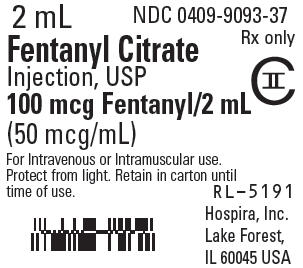
-
PRINCIPAL DISPLAY PANEL - 2 mL Ampule Cello Pack Label
2 mL Single-dose 10 Ampuls
Rx only
NDC: 0409-9093-32
Contains 10 of NDC: 0409-9093-37Fentanyl Citrate Injection, USP
100 mcg Fentanyl/2 mL
(50 mcg/mL)CII
Protect from light. Keep ampuls in tray until time of use.
For Intravenous or Intramuscular use.Each mL contains fentanyl (as the citrate) 50 mcg (0.05 mg). May
contain sodium hydroxide and/or hydrochloric acid for pH adjustment.
pH 4.7 (4.0 to 7.5). Usual dosage: See insert. Store at 20 to 25°C
(68 to 77°F). [See USP Controlled Room Temperature.]Distributed by
Hospira, Inc., Lake Forest, IL 60045 USAHospira
RL-7313
LOT ##-###-AA
EXP DMMMYYYYTamper Evident Tray
Directions for ampul verification:
1. Verify shrink-wrap is intact and all ampuls present.
2. Do not unwrap tray prior to dispensing.For your convenience in recording narcotic use
INITIAL/DATE
1.
2.
3.
4.
5.INITIAL/DATE
6.
7.
8.
9.
10.
-
PRINCIPAL DISPLAY PANEL - 5 mL Ampule Label
5 mL
NDC: 0409-9093-45
Rx onlyFentanyl Citrate
Injection, USP250 mcg Fentanyl/5 mL
CII
(50 mcg/mL)For Intravenous or Intramuscular use. Protect from light.
Retain in carton until time of use.Dist. by Hospira, Inc., Lake Forest, IL 60045 USA
RL-7698
LOT ##-##-AA
EXP DMMMYYYY
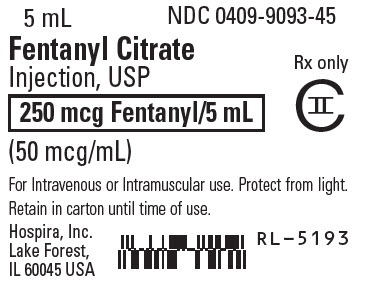
-
PRINCIPAL DISPLAY PANEL - 5 mL Ampule Cello Pack Label
5 mL Single-dose 10 Ampuls
NDC: 0409-9093-35
Contains 10 of NDC: 0409-9093-45Fentanyl Citrate Injection, USP
Rx only250 mcg Fentanyl/5 mL
CII
(50 mcg/mL)Protect from light. Keep ampuls in tray until time of use.
For Intravenous or Intramuscular use.
Each mL contains fentanyl (as the citrate) 50 mcg (0.05 mg). May contain sodium
hydroxide and/or hydrochloric acid for pH adjustment. pH 4.7 (4.0 to 7.5). Usual dosage:
See insert. Store at 20 to 25°C (68 to 77°F). [See USP Controlled Room Temperature.]Hospira
Distributed by Hospira, Inc., Lake Forest, IL 60045 USA
RL-7315
LOT ##-###-AA
EXP DMMMYYYYTamper Evident Tray
Directions for ampul verification:
1. Verify shrink-wrap is intact and all ampuls present.
2. Do not unwrap tray prior to dispensing.For your convenience in recording narcotic use
INITIAL/DATE
1.
2.
3.
4.
5.INITIAL/DATE
6.
7.
8.
9.
10.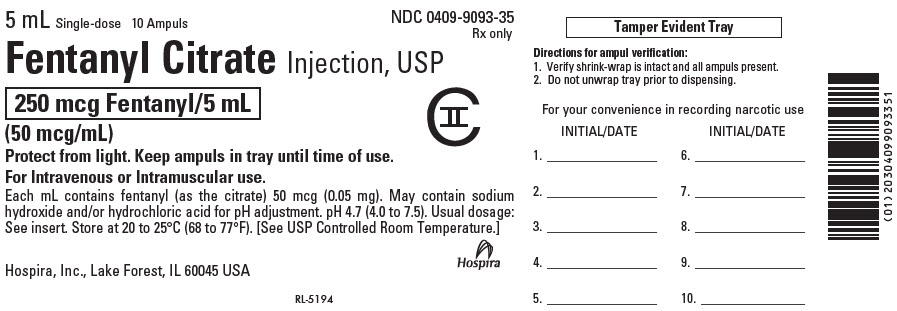
- PRINCIPAL DISPLAY PANEL - 10 mL Ampule Label
-
PRINCIPAL DISPLAY PANEL - 10 mL Ampule Carton
10 mL
Single-dose
5 AmpulsDiscard unused portion
NDC: 0409-9093-36
Fentanyl Citrate Injection, USP
500 mcg Fentanyl/10 mL
(50 mcg/mL)CII
Hospira
Protect from light. Retain in carton until time of use.
Each mL contains fentanyl (as the citrate) 50 mcg (0.05 mg). May contain sodium hydroxide and/or hydrochloric acid
for pH adjustment. pH 4.7 (4.0 to 7.5). Sterile, nonpyrogenic.
Usual dose: See insert. Store at 20 to 25°C (68 to 77°F). [See USP Controlled Room Temperature.]
-
PRINCIPAL DISPLAY PANEL - 20 mL Ampule Label
20 mL Single-dose
Discard unused portion
Rx onlyFentanyl
Citrate
Injection, USP1000 mcg Fentanyl/20 mL
(50 mcg/mL)FOR INTRAVENOUS USE BY HOSPITAL
PERSONNEL SPECIFICALLY TRAINED IN
THE USE OF NARCOTIC ANALGESICS.Distributed by Hospira, Inc., Lake Forest, IL 60045 USA
NDC: 0409-9093-31
Each mL contains fentanyl (as
the citrate) 50 mcg (0.05 mg).
May contain NaOH and/or HCl
for pH adjustment. pH 4.7 (4.0
to 7.5). Protect from light.
Retain in carton until time of
use. Store at 20 to 25°C (68 to
77°F). [See USP Controlled
Room Temperature.]CII
Hospira
RL-7316
LOT ##-###-AA
EXP DMMMYYYY
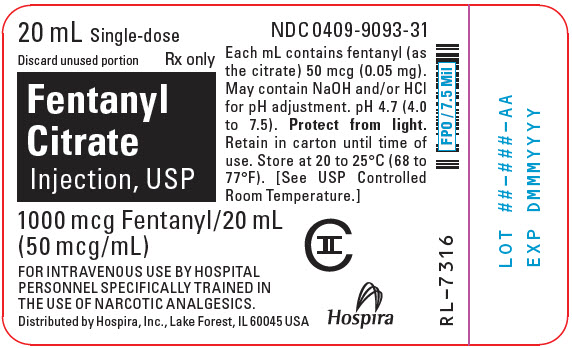
-
PRINCIPAL DISPLAY PANEL - 20 mL Ampule Carton
20 mL
Single-dose
5 AmpulsNDC: 0409-9093-38
Contains 5 of NDC: 0409-9093-31Discard unused portion
Rx only
Fentanyl Citrate
Injection, USP1000 mcg Fentanyl/20 mL
(50 mcg/mL)CII
Protect from light.
Retain in carton until time of use.
FOR INTRAVENOUS ADMINISTRATION BY
HOSPITAL PERSONNEL SPECIFICALLY TRAINED
IN THE USE OF NARCOTIC ANALGESICS.Distributed by
Hospira, Inc., Lake Forest, IL 60045 USAHospira
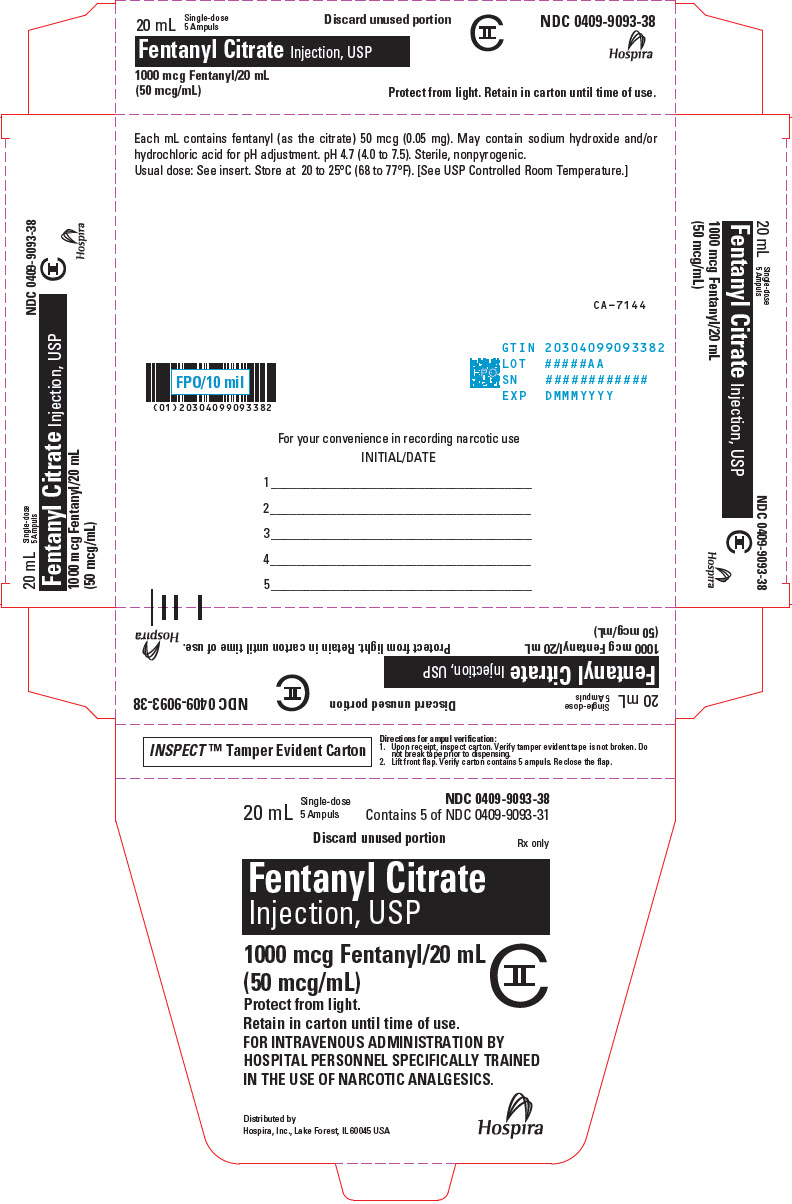
-
PRINCIPAL DISPLAY PANEL - 2 mL Vial Label
2 mL Single-dose
NDC: 0409-9094-12
Rx onlyIntravenous or
Intramuscular UseFentanyl Citrate
Inj., USP
CII
100 mcg Fentanyl/2 mL
(50 mcg/mL)Distributed by Hospira, Inc.
Lake Forest, IL 60045 USAHospira
RL-7310
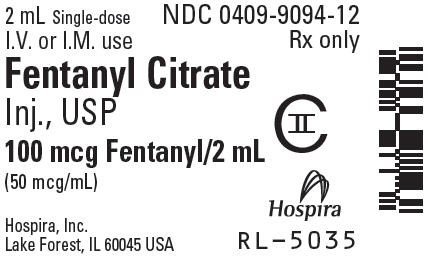
-
PRINCIPAL DISPLAY PANEL - 2 mL Vial Tray Top
2 mL
Single-dose
25 Fliptop Vials
Discard unused portion.
NDC: 0409-9094-22
Contains 25 of NDC: 0409-9094-12Fentanyl Citrate
Injection, USP
100 mcg Fentanyl/2 mL
(50 mcg/mL)
CIIProtect from light.
Retain in tray until time of use.
For Intravenous or Intramuscular use.
Rx onlyCA-7136
Distributed by
Hospira, Inc., Lake Forest, IL 60045 USAHospira

-
PRINCIPAL DISPLAY PANEL - 2 mL Vial Tray
2 mL
Single-dose 25 Fliptop Vials
NDC: 0409-9094-22
Discard unused portion.Fentanyl Citrate Inj., USP
100 mcg Fentanyl/2 mL
(50 mcg/mL)
Rx only
CIIRetain in tray until time of use.
Protect from light.
For Intravenous or Intramuscular use.Hospira

-
PRINCIPAL DISPLAY PANEL - 5 mL Vial Label
5 mL
Single-dose Vial
NDC: 0409-9094-18
Rx onlyFentanyl Citrate
Injection, USP
CII250 mcg Fentanyl/5 mL
(50 mcg/mL)Distributed by Hospira, Inc.
Lake Forest, IL 60045 USAHospira

-
PRINCIPAL DISPLAY PANEL - 5 mL Vial Tray Top
5 mL Single-dose
25 Fliptop Vials
Rx only
NDC: 0409-9094-25
Contains 25 of NDC: 0409-9094-18Fentanyl Citrate
Injection, USP
CII250 mcg Fentanyl/5 mL
(50 mcg/mL)
For Intravenous or Intramuscular use.
Protect from light.
Retain in tray until time of use.
Discard unused portion.Distributed by
Hospira, Inc., Lake Forest, IL 60045 USAHospira
CA-7140
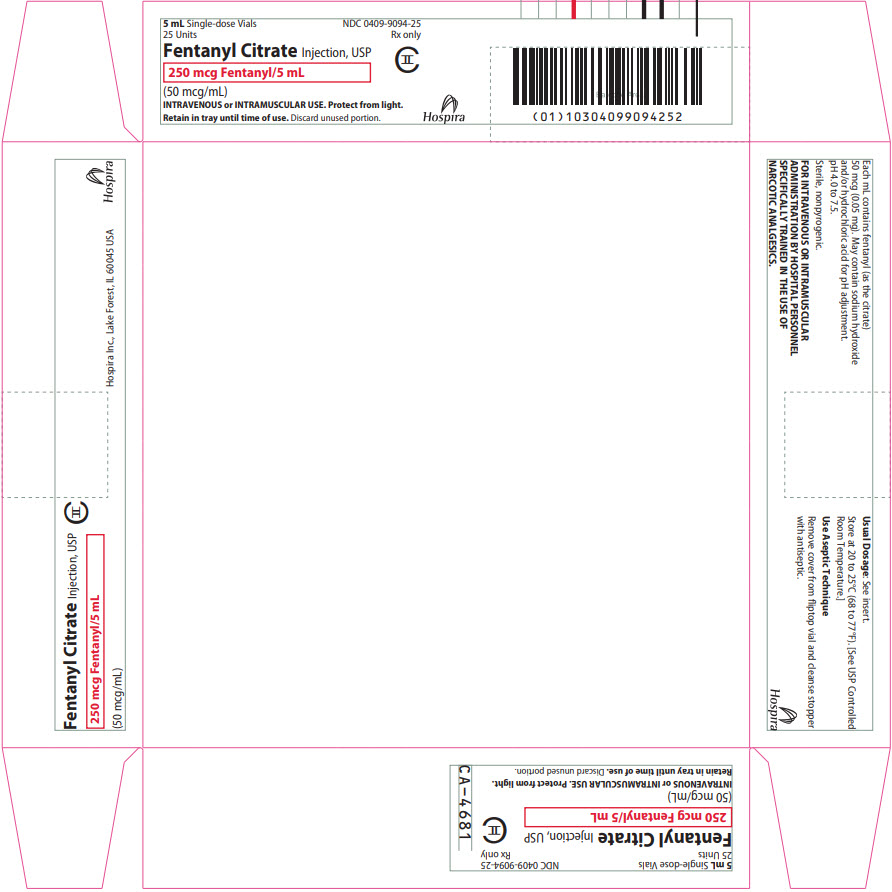
-
PRINCIPAL DISPLAY PANEL - 5 mL Vial Tray
5 mL Single-dose Vials
25 Units
NDC: 0409-9094-25
Rx onlyFentanyl Citrate Injection, USP
CII
250 mcg Fentanyl/5 mL
(50 mcg/mL)INTRAVENOUS or INTRAMUSCULAR USE. Protect from light.
Retain in tray until time of use. Discard unused portion.Hospira
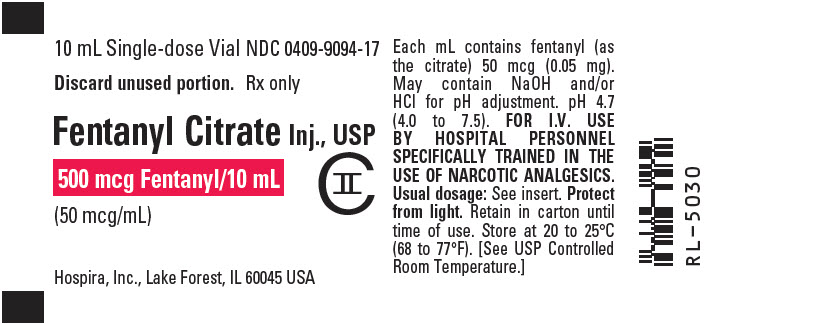
-
PRINCIPAL DISPLAY PANEL - 10 mL Vial Label
10 mL Single-dose Vial NDC: 0409-9094-17
Discard unused portion. Rx only
Fentanyl Citrate Inj., USP
500 mcg Fentanyl/10 mL
CII
(50 mcg/mL)Distributed by
Hospira, Inc., Lake Forest, IL 60045 USA
-
PRINCIPAL DISPLAY PANEL - 10 mL Vial Tray
10 mL Single-dose 25 Fliptop Vials
Discard unused portion
NDC: 0409-9094-28
Contains 25 of NDC: 0409-9094-17Fentanyl Citrate Injection, USP CII
500 mcg Fentanyl/10 mL
(50 mcg/mL)
Rx only
Protect from light. Retain in carton until time of use.Hospira
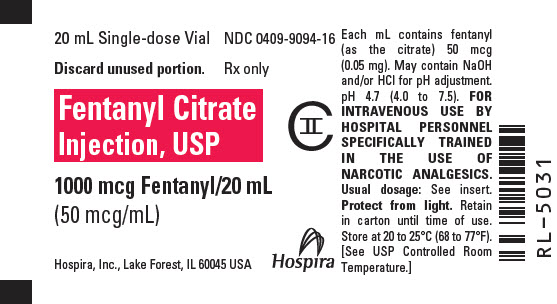
-
PRINCIPAL DISPLAY PANEL - 20 mL Vial Label
20 mL Single-dose
Vial NDC: 0409-9094-16Discard unused portion.
Rx onlyFentanyl Citrate
Injection, USP
CII1000 mcg Fentanyl/20 mL
(50 mcg/mL)Distributed by
Hospira, Inc., Lake Forest, IL 60045 USAHospira
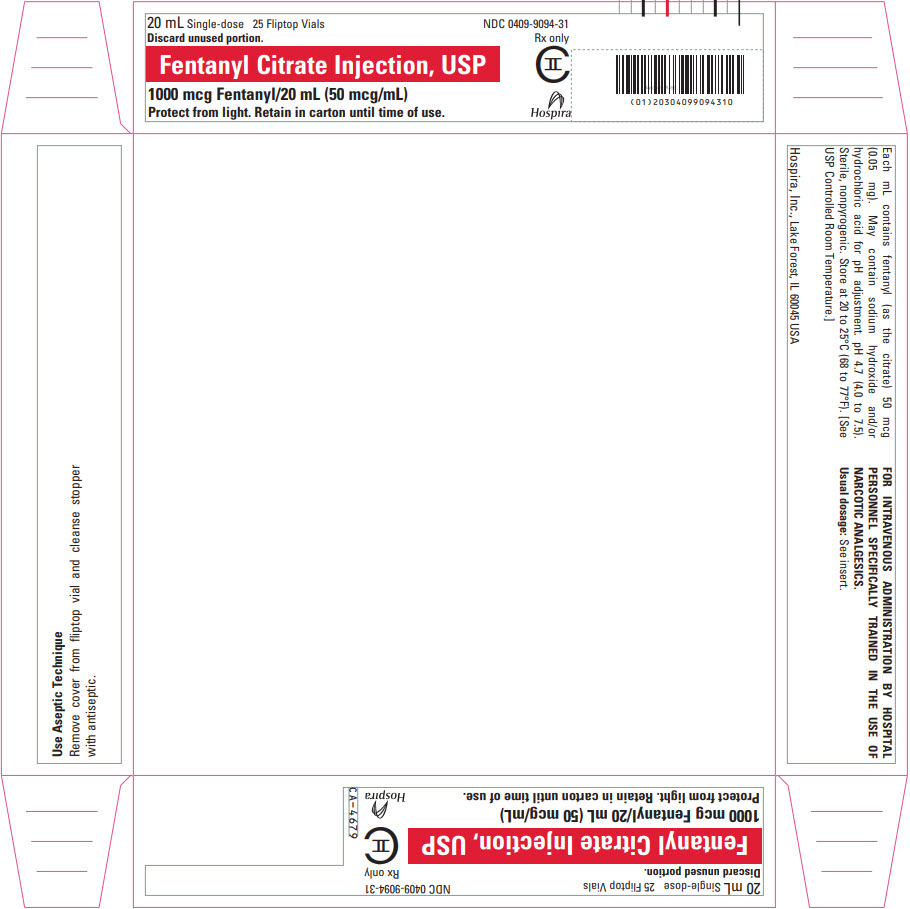
-
PRINCIPAL DISPLAY PANEL - 20 mL Vial Tray
20 mL Single-dose 25 Fliptop Vials
Discard unused portion.
Rx only
NDC: 0409-9094-31
Contains 25 of NDC: 0409-9094-16Fentanyl Citrate Injection, USP
CII1000 mcg Fentanyl/20 mL (50 mcg/mL)
Protect from light. Retain in carton until time of use.Hospira
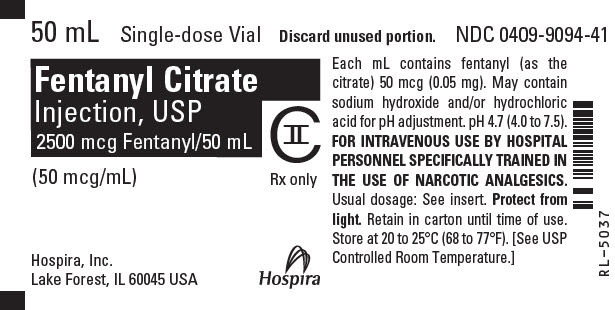
- PRINCIPAL DISPLAY PANEL - 50 mL Vial Label
-
PRINCIPAL DISPLAY PANEL - 50 mL Vial Carton
One/NDC: 0409-9094-41
Rx only50 mL
Single-dose
Fliptop VialDiscard unused portion.
Fentanyl
Citrate
Injection, USP
2500 mcg Fentanyl/50 mL
CII(50 mcg/mL)
Protect from light.
Retain in carton
until time of use.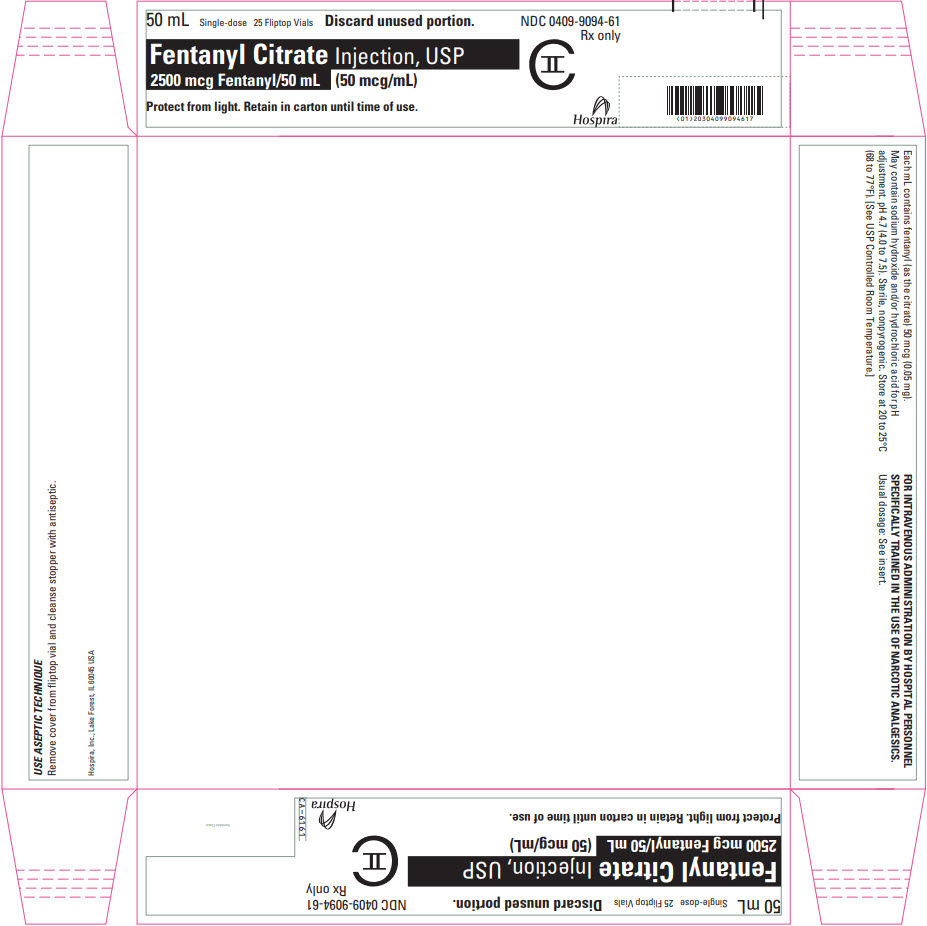
-
PRINCIPAL DISPLAY PANEL - 50 mL Vial Carton Tray
50 mL
Single-dose
25 Fliptop Vials
Discard unused portion.
NDC: 0409-9094-61
Contains 25 of NDC: 0409-9094-41
Rx onlyFentanyl Citrate Injection, USP
2500 mcg Fentanyl/50 mL
(50 mcg/mL)
CIIProtect from light. Retain in carton until time of use.
Hospira
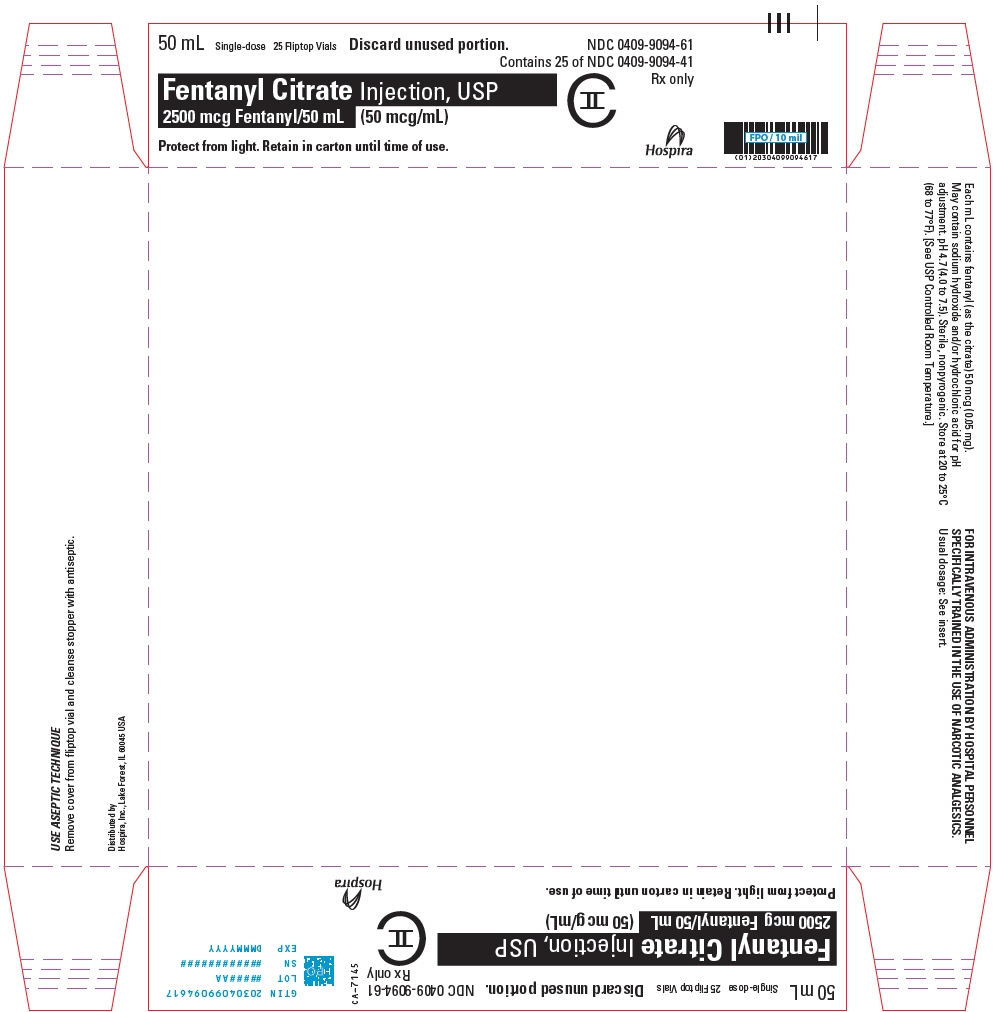
-
INGREDIENTS AND APPEARANCE
FENTANYL CITRATE
fentanyl citrate injection, solutionProduct Information Product Type HUMAN PRESCRIPTION DRUG Item Code (Source) NDC: 0409-9093 Route of Administration INTRAMUSCULAR, INTRAVENOUS DEA Schedule CII Active Ingredient/Active Moiety Ingredient Name Basis of Strength Strength FENTANYL CITRATE (UNII: MUN5LYG46H) (FENTANYL - UNII:UF599785JZ) FENTANYL 50 ug in 1 mL Inactive Ingredients Ingredient Name Strength SODIUM HYDROXIDE (UNII: 55X04QC32I) HYDROCHLORIC ACID (UNII: QTT17582CB) WATER (UNII: 059QF0KO0R) Packaging # Item Code Package Description Marketing Start Date Marketing End Date 1 NDC: 0409-9093-32 10 in 1 CELLO PACK 11/15/2005 1 NDC: 0409-9093-37 2 mL in 1 AMPULE; Type 0: Not a Combination Product 2 NDC: 0409-9093-35 10 in 1 CELLO PACK 12/14/2005 2 NDC: 0409-9093-45 5 mL in 1 AMPULE; Type 0: Not a Combination Product 3 NDC: 0409-9093-36 5 in 1 CARTON 07/20/2006 09/01/2011 3 NDC: 0409-9093-41 10 mL in 1 AMPULE; Type 0: Not a Combination Product 4 NDC: 0409-9093-38 5 in 1 CARTON 03/01/2006 09/01/2018 4 NDC: 0409-9093-31 20 mL in 1 AMPULE; Type 0: Not a Combination Product Marketing Information Marketing Category Application Number or Monograph Citation Marketing Start Date Marketing End Date NDA NDA019115 11/15/2005 FENTANYL CITRATE
fentanyl citrate injection, solutionProduct Information Product Type HUMAN PRESCRIPTION DRUG Item Code (Source) NDC: 0409-9094 Route of Administration INTRAMUSCULAR, INTRAVENOUS DEA Schedule CII Active Ingredient/Active Moiety Ingredient Name Basis of Strength Strength FENTANYL CITRATE (UNII: MUN5LYG46H) (FENTANYL - UNII:UF599785JZ) FENTANYL 50 ug in 1 mL Inactive Ingredients Ingredient Name Strength SODIUM HYDROXIDE (UNII: 55X04QC32I) HYDROCHLORIC ACID (UNII: QTT17582CB) WATER (UNII: 059QF0KO0R) Packaging # Item Code Package Description Marketing Start Date Marketing End Date 1 NDC: 0409-9094-22 25 in 1 TRAY 12/02/2010 1 NDC: 0409-9094-12 2 mL in 1 VIAL, SINGLE-DOSE; Type 0: Not a Combination Product 2 NDC: 0409-9094-25 25 in 1 TRAY 11/09/2005 2 NDC: 0409-9094-18 5 mL in 1 VIAL, SINGLE-DOSE; Type 0: Not a Combination Product 3 NDC: 0409-9094-28 25 in 1 TRAY 02/17/2006 3 NDC: 0409-9094-17 10 mL in 1 VIAL, SINGLE-DOSE; Type 0: Not a Combination Product 4 NDC: 0409-9094-31 25 in 1 TRAY 09/27/2005 4 NDC: 0409-9094-16 20 mL in 1 VIAL, SINGLE-DOSE; Type 0: Not a Combination Product 5 NDC: 0409-9094-61 25 in 1 TRAY 12/22/2005 5 1 in 1 CARTON 5 NDC: 0409-9094-41 50 mL in 1 VIAL, SINGLE-DOSE; Type 0: Not a Combination Product Marketing Information Marketing Category Application Number or Monograph Citation Marketing Start Date Marketing End Date NDA NDA019115 09/27/2005 Labeler - Hospira, Inc. (141588017) Establishment Name Address ID/FEI Business Operations Hospira, Inc. 093132819 ANALYSIS(0409-9093, 0409-9094) , LABEL(0409-9093, 0409-9094) , MANUFACTURE(0409-9093, 0409-9094) , PACK(0409-9093, 0409-9094) Establishment Name Address ID/FEI Business Operations Hospira, Inc. 827731089 ANALYSIS(0409-9093, 0409-9094)
© 2026 FDA.report
This site is not affiliated with or endorsed by the FDA.


